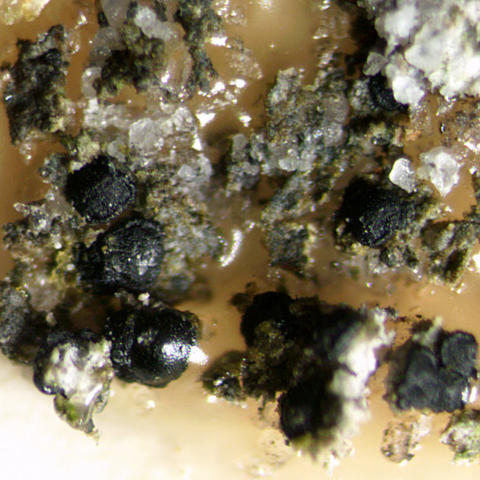Micarea ternaria (Nyl.) Vězda
Sched. Ad Lich. Sel. Exs., 35: 3 (nr. 858), 1970. Basionym: Lecidea sabuletorum f. ternaria Nyl. - Not. Sällsk. Fauna Fl. Fenn. Förh., Ny Ser., 8: 151, 1866.
Synonyms: Lecidea ternaria (Nyl.) Nyl.
Description: Thallus crustose, episubstratic, of scattered to confluent, whitish to ash-grey, usually convex or subglobose areoles. Apothecia micareoid, black or blue-black, sessile to substipitate, often tuberculate, 0.15-1 mm across, with a convex to almost globose disc, usually without a proper margin, but sometimes thinly marginate when young. Proper exciple poorly developed but evident in young apothecia, colourless or aeruginose green to olive-green in outer part, of radiating, branched and anastomosing hyphae; epithecium scarcely differentiated from the hymenium; hymenium 60-70 μm high, colourless but often with greenish vertical streaks in lower part, dark aeruginose green in upper part, the pigmented parts K-, N+ purple; paraphyses numerous, 1-1.8 μm thick at mid-level, simple or sparingly branched in upper part, the apical cells to 3 μm wide; hypothecium olivaceous or pale brown in upper part, colourless in lower part, up to 380 μm high. Asci 8-spored, clavate to cylindrical-clavate, with a K/I+ pale blue apical dome with a dark blue tubular structure. Ascospores (0-)1-3-septate, hyaline, fusiform, straight or slightly curved, 13-22(-24) x 3.5-5 μm. Pycnidia more or less immersed, the wall green (K-) in upper parts. Mesoconidia cylindrical to oblong-ellipsoid, sometimes slightly constricted in the middle, 4-7 x 1.2-2 μm. Photobiont micareoid, the cells 4-7 μm wide. Spot tests: thallus and apothecial sections K-, C-, KC-, P-, UV-. Chemistry: without lichen substances.
Growth form: Crustose
Photobiont: green algae other than Trentepohlia
Reproductive strategy: mainly sexual
Commonnes-rarity: (info)
Alpine belt: extremely rare
Subalpine belt: extremely rare
Montane belt: absent
Dry submediterranean belt: absent
Humid submediterranean belt: absent
Padanian area: absent
pH of the substrata:
1 2 3 4 5
Solar irradiation:
1 2 3 4 5
Aridity:
1 2 3 4 5
Eutrophication:
1 2 3 4 5
Poleotolerance:
0 1 2 3
Altitudinal distribution:
1 2 3 4 5 6
Rarity
absent
extremely rare
very rare
rare
rather rare
rather common
common
very common
extremely common
Loading data...
Occurrence data
Predictive map
Growth form: Crustose
Photobiont: green algae other than Trentepohlia
Reproductive strategy: mainly sexual
Commonnes-rarity: (info)
Alpine belt: extremely rare
Subalpine belt: extremely rare
Montane belt: absent
Dry submediterranean belt: absent
Humid submediterranean belt: absent
Padanian area: absent
pH of the substrata:
| 1 | 2 | 3 | 4 | 5 |
Solar irradiation:
| 1 | 2 | 3 | 4 | 5 |
Aridity:
| 1 | 2 | 3 | 4 | 5 |
Eutrophication:
| 1 | 2 | 3 | 4 | 5 |
Poleotolerance:
| 0 | 1 | 2 | 3 |
Altitudinal distribution:
| 1 | 2 | 3 | 4 | 5 | 6 |
Rarity
absent
extremely rare
very rare
rare
rather rare
rather common
common
very common
extremely common
Loading data...
Occurrence data
Predictive map







